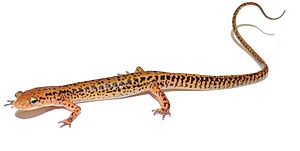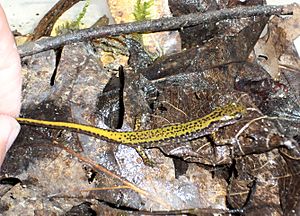Long-tailed salamander facts for kids
Quick facts for kids Long-tailed salamander |
|
|---|---|
 |
|
| Conservation status | |
| Scientific classification | |
| Synonyms | |
|
The Eurycea longicauda, also known as the long-tailed salamander, is a type of lungless salamander. This means it breathes through its skin and the lining of its mouth, not with lungs! These amazing creatures live in the Appalachian Region of the eastern United States.
Long-tailed salamanders are often called "cave salamanders" because they like to hang out near the entrances of caves. You can also find them near springs and in the forests around these watery places.
Contents
Types of Long-tailed Salamanders
Scientists group animals into different types. Sometimes, a species can have smaller groups called subspecies. These groups are a bit different from each other, but they are still the same species.
There are a few known subspecies of the long-tailed salamander:
- E. l. longicauda (This is the main long-tailed salamander)
- E. l. melanopleura (Also called the dark-sided salamander)
- E. l. pernix (Known as the Midland long-tailed salamander)
Another salamander, Eurycea guttolineata, used to be thought of as a subspecies of the long-tailed salamander. But now, scientists agree it's its own separate species!

What They Look Like
Long-tailed salamanders are quite colorful! Their bodies can be yellow, orange-red, or even bright red. They have random black spots all over them.
The main type, E. l. longicauda, has a body that's about 50 millimeters (about 2 inches) long from its snout to its bottom. But their tail is even longer, usually around 72 millimeters (about 2.8 inches)! That's how they got their name.
Life Cycle and Reproduction
The dark-sided subspecies, E. l. melanopleura, usually reproduces between November and February. The eggs are tiny, about 7 millimeters (0.28 inches) across.
Baby salamanders, called larvae, hatch from January to March. They are very small, only about 10 millimeters (0.4 inches) long when they first hatch. After about seven months, they go through a change called metamorphosis. This is when they lose their gills and change into their adult form. At this point, they are usually 23 to 28 millimeters (0.9 to 1.1 inches) long.
Male salamanders become ready to reproduce when they are about 31 to 43 millimeters (1.2 to 1.7 inches) long. Females are ready when they are about 33 to 43 millimeters (1.3 to 1.7 inches) long. The biggest long-tailed salamanders can grow to be about 55 millimeters (2.2 inches) long.
Where They Live and How They Are Protected
Long-tailed salamanders love places with water. You can find them along streams, near springs, in ponds, at the entrances of caves, and even in old, abandoned mines.
When the weather is wet, they might explore nearby forests. They like to hide in cracks in rocks or under rocks and logs to stay safe. When it's time to lay eggs, the females usually find underground cracks connected to water. In caves, they might attach their eggs to things in or above the water.
There are many long-tailed salamanders in the world, probably more than 100,000! So, they are not currently in danger of disappearing. However, some local groups of salamanders have been affected by things like strip mining and acid drainage from coal mines. But overall, there aren't any huge threats to the species. Many of the places where they live are protected areas, which helps keep them safe.


